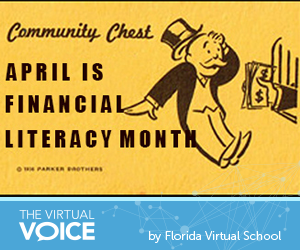Celebrate Financial Literacy Month
 Too often, parents wait until their kids are teens to begin teaching financial skills.
Too often, parents wait until their kids are teens to begin teaching financial skills.
However, kids as early as preschool can begin to learn proper financial literacy.
As parents, we tend to focus on ensuring our kids get a proper education in Language Arts, Math, Science, and Social Studies. We sometimes forget that financial literacy is just as important to learn.
It’s never too early to start teaching your children about financial literacy.
Parents have the strongest influence over their kids’ current and future money management skills.
According to a Schwab 2011 survey of teens, 82 percent of teens surveyed say their parents teach them about money management. Of those teens surveyed, 77 percent report their parents have been great role models. Teens are happy when their parents teach them about money. It’s evident that parents have the power to make the most difference in their child’s adult life and financial literacy skills.
To help you begin, here are some tips for teaching your child financial literacy.
Ages 3 – 4
Preschoolers can learn to identify coins and their value. For example, you can play games and help your child identify a penny, dime, nickel, and quarter. Have them trace the coins and color them. As you teach them to identify whole numbers – match coins with numbers.
Ages 5 – 7
Teach your child the value of money and the power of saving. Remember the old piggy bank we all had as kids? Get a piggy bank or a jar. Have your child save the coins they find, earn, or get from grandparents. Have them identify each coin’s worth. Later, take them to the dollar store to buy a toy or candy. In this simple act you are teaching your youngster that money helps purchase the things we want/need.
Ages 8 – Middle School
Teach your kids work ethic and the power of giving. When we work, we get paid. It’s through hard work that mom and dad bring home the money needed to put food on the table, clothes on our backs, and that fancy laptop that we use for school. Give your child age-appropriate chores to help with at home: take out the trash, help bring in groceries, put away laundry, clean up your room, etc.
This is also a great age to start teaching kids about giving. Separate 10 percent of what they have earned each week or month. Use that money to help a local charity or a friend in need. Through giving and donations, our children learn that money can also be used to bless others in need.
This is also a great time to move out of the piggy bank and into an actual bank account. Many financial institutions offer Student Savings Accounts. Check your local bank for this opportunity.
High School
According to a Schwab 2011 survey of teens, 86 percent prefer to learn about money management in a course before graduating so as to avoid making mistakes when they are older.
With this in mind, FLVS is proud to offer courses like Personal and Family Finance, Economics with Financial Literacy, and Dave Ramsey’s Foundations in Personal Finance High School Edition.
In these courses, students learn how money impacts their world. Why do we pay taxes? How do credit cards work? How can students learn to spend money without going into debt? How do we invest in our own future? After completing the course, not only will students earn a half credit, but they will better understand how the financial world works and have the knowledge to manage their personal and family finances effectively.
Resources:
Charles Schwab 2011 Teens and Money Survey Findings: http://www.schwabmoneywise.com/public/moneywise/calculators_tools/families_money_surveys/teens_money_survey
http://www.schwabmoneywise.com/public/file/P-4192268/110526-SCHWAB-TEENSMONEY.pdf
Post by: Patty Cordones, FLVS School Counselor
